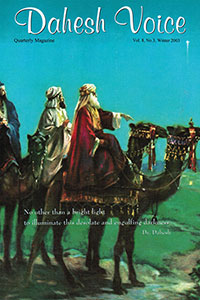
Globalization and its Consequences
The debate about the benefits of globalization remains. However, whether it is met with praise or apprehension, all state leaders and political scientists agree and warn against future world crises and dangers which would affect all countries, regardless of their
geographic situation or economic condition. What statesmen and illuminated thinkers came to comprehend recently, Dr. Dahesh had warned against in the forties: he was tenaciously against war, terrorism, illiteracy and slavery, always dreaming of “One World” where peace, brotherhood, justice, and freedom would reign (See Dr. Brax’s article in Ar. Sec., p. 5).
Mr. AI-Araji ascertains that globalization seems to be inevitable, but unfortunately, for several reasons, the Arab World is still unmindful of it and is unprepared to share its expected benefits (Ar. Sec., p. 19). Ms. Ghalia Khoja reviews Lazqani’s book. The Mills of Talk, and displays the author’s humor and sarcasm in unveiling the state of decadence in which various aspects of Arab life are lost (Ar. Sec., p. 75). An important factor, probably, is illiteracy, which is a major universal problem that detains the progress of civilizations. Dr. Haouili demonstrates that illiteracy is still relatively widespread throughout the world, and displays its causes and bad consequences, particularly on Arab countries (Ar. Sec., p. 65).
The English Section includes an article by Dr. G. El- Hage on “A Communicative Approach to Teaching Arabic in Academia” where he highlights the significance of the modern methodologies and approaches in teaching Arabic as a second language, as well as the role of the instructor, the learner, the classroom and the textbook (p. 4).
It also includes the second part of Dr. Popp’s article on the famous Arab-American review, Al-Funun, in which the Orientalist illustrates some unknown aspects of that journal, underlining the role of Nasib Anda in the Arab-American literary movement (p. 12). In addition, Mr. Vladimir Wertsman writes about the exhibit ion at the Museum of the City of New York (p. 31) that focused on the history of the Arab-American community in New York City, its development, family and community life, and contributions in various fields of arts and sciences.
The recent discovery of the first archaeological proof of the existence of Jesus of Nazareth is discussed tn this issue (p. 20; Ar. Sec., p. 51). The new discovery confirms what Dr. Dahesh had announced 60 years ago, in his book Memoirs of Jesus oj Nazareth, that Jesus had a brother called Jacob. An ossuary that bears the Aramaic inscription which reads “Jacob, son of Joseph, brother of Jesus” was discovered in Jerusalem.
This issue also includes a chant by Dr. Dahesh to the Savior(Ar. Sec., p. 63), a testimony about Dr. Dahesh offered by the well-known writer and- painter, Mrs. Marie Hadad (Ar. Sec., p. 48), an essay on civilization by Mr. Shikhani (Ar. Sec., p. 35), and an article by Ms. Alloush on the history of Beirut from the last, decades of the Ottoman era until the Lebanese Civil War in 1975 (Ar. Sec., p. 38), along with three distinguished poems by Mr. Ahmed Lutfi, Dr. Serna'an Salem, and Dr. Mounir Ashquti (Ar. Sec., pp. 84-86).
The Editor
